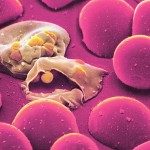Lien vers Pubmed [PMID] – 24878724
Lien DOI – 10.1504/IJCBDD.2014.061655IJCBDD.2014.061655
Int J Comput Biol Drug Des 2014 ; 7(2-3): 113-29
Using a unique combination of visual, statistical, and data mining methods, we tested the hypothesis that an immune cell’s movement pattern can convey key information about the cell’s function, antigen specificity, and environment. We applied clustering, statistical tests, and a support vector machine (SVM) to assess our ability to classify different datasets of imaged flouresently labelled T cells in mouse liver. We additionally saw clusters of different movement patterns of T cells of identical antigenic specificity. We found that the movement patterns of T cells specific and non-specific for malaria parasites are differentiable with 72% accuracy, and that specific cells have a higher tendency to move towards the parasite than non-specific cells. Movements of antigen-specific T cells in uninfected mice vs. infected mice were differentiable with 69.8% accuracy. We additionally saw clusters of different movement patterns of T cells of identical antigenic specificity. We concluded that our combination of methods has the potential to advance the understanding of cell movements in vivo.

